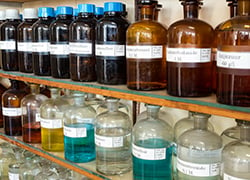To ensure lab safety and regulatory compliance, you need to accurately track and manage your chemicals and hazardous materials on an ongoing basis. If your chemical inventory program doesn't cover all of the unique aspects of your lab operations, you might be risking violations and the safety of your personnel. Triumvirate Environmental not only gets your chemical inventory program up and running, but we also ensure data accuracy to fulfill reporting requirements and a streamlined, continuous operation supported by cloud-based software.
Assess, Develop, and Improve Your Chemical Inventory System
Triumvirate’s chemical inventory management services, complete with cloud-based chemical inventory management software, make developing, implementing, and managing a chemical inventory program easy, affordable, and sustainable. We will:
- Design your chemical inventory program – Our experienced team will assess your unique needs, current processes, existing workflows, and regulatory compliance to develop a comprehensive chemical inventory plan.
- Provide chemical inventory management software to easily manage your chemicals and safety data sheets (SDSs) – The flexible, subscription-based software tracks chemicals and SDSs, generates detailed data for chemical inventory reporting. We ensure the chemical inventory software’s successful roll-out and provide web-based training and ongoing support. Learn more about the software.
- Launch and operationalize your program – Our team initially loads your data and SDSs into the chemical management software. We reconcile barcodes, add missing barcodes and SDSs, and check the data for accuracy.
- Provide ongoing maintenance of chemical inventory and SDSs – We offer comprehensive operational support based on your needs – ranging from being on-site daily to receive and barcode chemicals to performing annual reconciliations.
We Offer Chemical Inventory Software Plus Experience
Our intimate understanding of research labs and chemical inventory programs, coupled with chemical inventory management software, makes Triumvirate the only company that can design, implement, and support all aspects of your chemical inventory program. Contact us today.
Chemical Inventory Resources
For more information about the benefits of chemical inventory management, read these blog posts from our experts:



